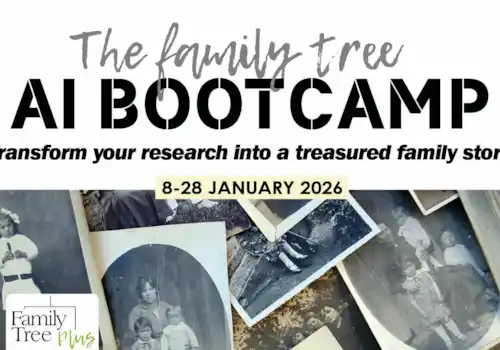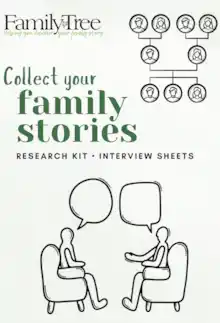Family Tree reader Nick Wilkinson has spent years trying to learn where his grandad served in WWI. Using Findmypast’s military records, and guidance from researcher Jen Baldwin, we traced his service and uncovered the wider story of six brothers who all came home. Here’s what we found, and how you can do the same.
‘I've been trying for years to find out where my Grandad served in the First World War,’ Family Tree reader Nick Wilkinson recently told us. ‘What's really fascinating is that, according to family stories, he was one of six brothers who all served in WWI – and who all came back alive.’
Like Nick, we couldn’t resist delving deeper, and Findmypast’s extensive military collections were the perfect place to start.
These detailed records bring your ancestors’ service stories to life – and with expert insights from Findmypast researcher Jen Baldwin, we uncovered remarkable new details about Nick’s wartime family.
Read on to discover their incredible story and learn how you can trace the footsteps of your own wartime ancestors with Findmypast.
In association with Findmypast
Band of brothers
When parents Edmund Wilkinson and Margaret Eliza gave birth to their sixth son, in 1898, they would have had no idea of the worries and world war that lay ahead.Reader Nick Wilkinson’s grandad was their second son, Al bert Gordon Wilkinson, born in Cheshire in 1889, and it is his story that we will pick up first.
Nick's WW1 grandad: Gunner Albert Gordon Wilkinson
At the outbreak of WW1, Albert was a 24-year-old young married man, working as a warehouseman in London, and whose daughter Margaret had been born just a few months before.
‘Albert’s British War and Victory Medals, which are still in the family, have his regimental number of 119786 engraved around the outside rim,’ explains Nick. ‘He was in the Royal Garrison Artillery in the Heavy Trench Mortars.
‘One thing that was an enormous help were the Absent Voter’s Lists for the Wirral and Hastings on Findmypast.
‘From the Absent Voters’ List for 24 Vicarage Road, Hastings, his regimental details are noted as “119786 Gnr 5/7th H.T.N. Bty no,1877 RGA” and next to this written in red pen "BEF".
‘I would dearly like to find where he actually was fighting during WWI to potentially visit the area.’
Findmypast researcher Jen Baldwin picked up the baton to help delve deeper into Nick’s grandad’s WWI experiences.
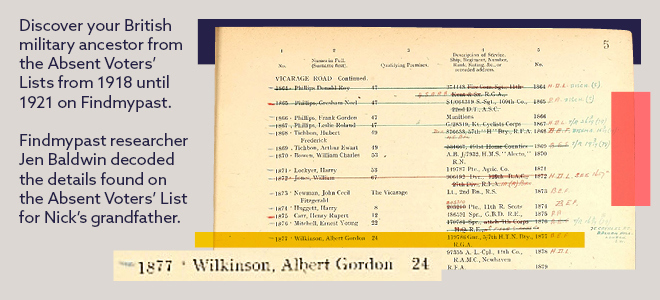
Decoding the clues
Nick shared that the Absent Voters’ List recorded the following details for Albert: “119786 Gnr 5/7th H.T.N. Bty No.1877 RGA”. But what does this mean?
Jen Baldwin from Findmypast explains:
|
119786 |
His service number — unique to him within the Royal Garrison Artillery (RGA). |
|
Gnr |
Abbreviation for Gunner, the RGA equivalent of a Private. |
|
5/7th H.T.N. Bty |
This identifies his unit — 5/7th Heavy Trench Mortar Battery. |
|
No. 1877 |
Likely an internal or administrative number for that specific battery (used to distinguish it among other RGA formations). It’s not his personal number — think of it as the battery’s War Office reference or “serial.” |
|
RGA |
Royal Garrison Artillery, the branch responsible for all heavy and siege guns, as well as heavy trench mortars. |
|
BEF (in red ink) |
Indicates he was serving overseas with the British Expeditionary Force — i.e., in France or Flanders at the time of the Absent Voters Register (1918–1919). |
Learn about the unit
Jen’s insights:
The Royal Garrison Artillery (RGA) was originally responsible for heavy guns, coastal defences, and siege artillery. It took charge of all heavy and siege guns, howitzers, and trench mortars (the latter from 1916 onward). The RGA expanded massively during WWI and by 1917, it was operating not only giant 9.2-inch howitzers but also the Heavy Trench Mortar Batteries (TMBs) attached to divisions and corps.
Where was he actually fighting?
Jen tracked down the battles that Albert’s Battery most likely served in.
The “5/7th” was The 7th Heavy Trench Mortar Battery, attached to the 5th Division of the British Expeditionary Force. The 5th Division served almost continuously on the Western Front, in:
1916: the Somme
1917: Arras, Polygon Wood / Passchendaele
1918: the German Spring Offensive, then the Hundred Days Offensive
Thanks to Jen, Nick now has locations to visit in the future to see where his grandad once fought.
Nick's great-uncle: Merchant Seaman Leonard Field Wilkinson
Moving on to Nick’s great-uncle, Leonard, born in 1898, Nick writes: ‘A partial service record has survived for Leonard from which I have been able to ascertain that he was called up in 1917, attached to the Army Cycling Corps, and transferred to the Royal Engineers, and in his service record it states that he was employed in Cross Channel Services.
‘From Findmypast I found a CR10 Merchant Seaman card for Leonard Field, which I believe is a form of identity certificate issued during the First World War and the date on the record was 1918. I also found his CR1 and CR2 cards on Findmypast too. The CR2 card has a list of Merchant ships he served on (by registration number) post-WW1. I would like to understand a bit more about these cards.'
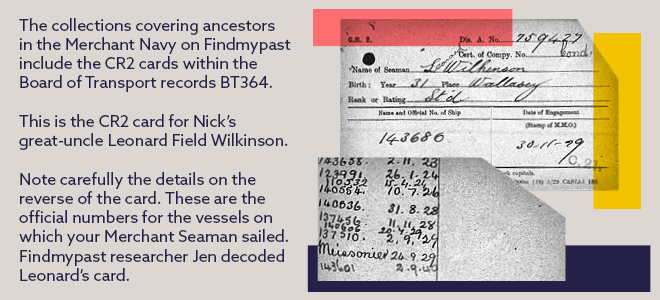
How the cards fit together
Jen stepped up to help explain the Merchant Seaman cards:
Think of the CR10 as the photo ID.
The CR1 is the master index card with identifying details.
The CR2 is the voyage/service log showing actual ships served on.
Together, they give a layered view: who the man was, what he looked like, and where he sailed.
A guide to CR 10 Cards
- Each card usually carries a passport-style photograph of the seaman. This is one of the very few official sources of photos for ordinary merchant seamen at the time.
- The cards were introduced in 1918 as a form of identity certificate.
- Include personal details (name, date and place of birth, physical description, discharge number, rating, etc.).
- Issued partly for wartime security reasons - to standardise identity documents and reduce fraud or desertion during the First World War.
These cards often overlap with the seaman’s service record but were primarily for ID, not a complete service log.
A guide to CR 1 Cards
- Essentially the index cards for individual Merchant seamen.
- Contain the seaman’s discharge number (unique identifying number) along with personal details.
- Used for keeping track of men across different ships and official paperwork.
- Do not usually list voyages in detail - more of a registry and administrative card.
A guide to CR 2 Cards
- These are the service record cards.
- They record the names or registration numbers of ships served on, often with dates of engagement and discharge.
- The sequence of ships listed gives you a partial career path after WWI.
- Some cards may also include port of registry codes, which can help identify the ship in Lloyd’s Register or Crew Lists.
Using the Official Numbers for the vessels and the dates, found on the reverse of the CR2 card for Leonard, researcher Jen built up a timeline of his service in the Merchant Navy.
|
Date on CR2 |
Ship (Official No. /ON) |
Type / Line |
Notes on Service & Routes |
|
2 Nov 1923 |
LANDES (ON143658) |
General cargo steamer, built 1920, Liverpool registry |
Coastal and continental trade; typical routes to Europe from UK. |
|
26 Jan 1924 |
KARNAK (ON 123991) |
Steamer (British India S.N. Co.) |
BI ships often ran to India/Bay of Bengal and East Africa. Crew lists in BT 99. |
|
15 Apr 1924 |
ROMNEY (ON 110532) |
Steamer, c.1915 |
Likely tramp cargo vessel; movements varied depending on charter. |
|
10 Jul 1926 |
SHERIDAN (ON 140554) |
Cargo steamer, Lamport & Holt |
South America trade (Liverpool–River Plate). |
|
31 Aug 1928 |
MILLAIS (ON 140536) |
Cargo steamer, Lamport & Holt |
South America trade; carried general cargo and passengers. |
|
11 Nov 1928 |
MACKEREL SKY (ON 137656) |
Fishing drifter/auxiliary vessel |
Smaller vessel, unusual for a merchant seaman—may indicate temporary coastal work. |
|
20 Apr 1929 |
LAPLACE (ON 140606) |
Cargo steamer, Lamport & Holt |
South America trade, Liverpool registry. |
|
2 Sep 1929 |
MOLIÈRE (ON 137510) |
Cargo steamer, Nelson Line |
7,000-ton vessel, built 1915, transatlantic and River Plate routes. |
|
24 Sep 1929 |
MEISSONIER (name only) (likely ON 137456) |
Cargo steamer, Nelson Line |
Sister ship to Molière; served South America. Clerk recorded name, not ON. |
|
2 Sep 1930 |
BRUYÈRE (ON 143601) |
Cargo steamer, Lamport & Holt |
Built 1919, Liverpool registry, South America trade.
|
Delving deeper into the details of Leonard's service
The details on the CR2 card revealed for Leonard:
- A strong connection to Lamport & Holt Line (Sheridan, Millais, Laplace, Bruyère) — all Liverpool-based ships serving the South American trades, especially the River Plate.
- Occasional service with Nelson Line (Molière, Meissonier), also on the South American run.
- Early voyages (Landes, Karnak, Romney) show a mix of tramp and British India service before settling into steady employment with the Liverpool-based lines.
- His appearance on Mackerel Sky (a drifter) suggests either a short coastal stint between liner contracts or local work during a gap.
We are concentrating here on WWI-era research, but it is interesting to note that Leonard also had a distinguished career in the Merchant Navy during World War II.
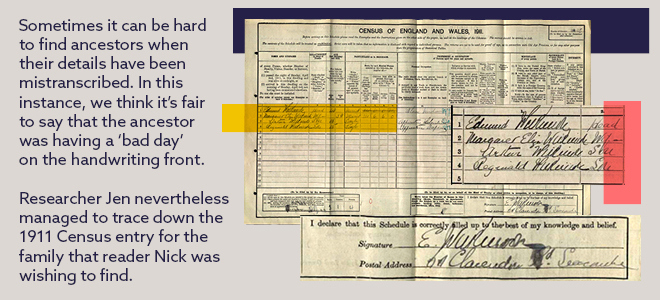
We hope these case studies into just two of Family Tree reader Nick Wilkinson’s family members who served in WWI have been helpful and will encourage you to delve deeper at Findmypast. With 120 million military records alone at Findmypast, we can always help you find out more about your family history.
Three top tips on using military records
- Explore the military collections on Findmypast comprising 120 million records.
- Take time to decode the details – the acronyms found on military records can look daunting but are rich in information about your ancestor’s time serving so are well worth investigating further.
- Save your findings & research notes – use Findmypast’s Workspaces feature to keep track of the records and details you gather in the course of your research.
🎖️ Free how-to webinar:
Discover your WWI military ancestors
Come to the FREE military records webinar – presented by Findmypast genealogist Jen Baldwin. The session will include a WWI case study and explore some of the 120 million military records available on Findmypast.
Date: Thursday 6th November
Time: 7pm (UK time)





